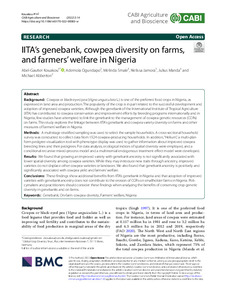| dc.contributor.author | Kouakou, A.G. |
| dc.contributor.author | Ogundapo, A.T. |
| dc.contributor.author | Smale, M. |
| dc.contributor.author | Jamora, N. |
| dc.contributor.author | Manda, J. |
| dc.contributor.author | Abberton, M. |
| dc.date.accessioned | 2022-05-23T14:14:11Z |
| dc.date.available | 2022-05-23T14:14:11Z |
| dc.date.issued | 2022 |
| dc.identifier.citation | Kouakou, A.G., Ogundapo, A.T., Smale, M., Jamora, N., Manda, J. & Abberton, M. (2022). IITA’s genebank, cowpea diversity on farms, and farmers’ welfare in Nigeria. CABI Agriculture and Bioscience, 3(1), 1-16. |
| dc.identifier.issn | 2662-4044 |
| dc.identifier.uri | https://hdl.handle.net/20.500.12478/7480 |
| dc.description.abstract | Background Cowpea or black-eyed pea (Vigna unguiculata L.) is one of the preferred food crops in Nigeria, as expressed in land area and production. The popularity of the crop is in part related to the successful development and adoption of improved cowpea varieties. Although the genebank of the International Institute of Tropical Agriculture (IITA) has contributed to cowpea conservation and improvement efforts by breeding programs internationally and in Nigeria, few studies have attempted to link the genebank to the management of cowpea genetic resources (CGRs) on farms. This study explores the linkage between IITA’s genebank and cowpea variety diversity on farms and other measures of farmers’ welfare in Nigeria. Methods A multistage stratified sampling was used to select the sample households. A cross-sectional household survey was conducted to collect data from 1524 cowpea-producing households. In addition, “Helium”, a multi-platform pedigree visualization tool with phenotype display was used to gather information about improved cowpea breeding lines and their pedigrees. For data analysis, ecological indices of spatial diversity were employed, and a conditional recursive mixed-process model and a multinomial endogenous treatment effect model were developed. Results We found that growing an improved variety with genebank ancestry is not significantly associated with lower spatial diversity among cowpea varieties. While they may introduce new traits through ancestry, improved varieties do not displace other cowpea varieties or landraces. We also found that genebank ancestry is positively and significantly associated with cowpea yield and farmers’ welfare. Conclusions These findings show additional benefits from IITA’s genebank in Nigeria and that adoption of improved varieties with genebank ancestry does not contribute to the erosion of CGRs on smallholder farms in Nigeria. Policymakers and practitioners should consider these findings when analyzing the benefits of conserving crop genetic diversity in genebanks and on farms. |
| dc.description.sponsorship | CGIAR Genebank Platform |
| dc.description.sponsorship | International Institute of Tropical Agriculture |
| dc.description.sponsorship | Crop Trust |
| dc.format.extent | 1-16 |
| dc.language.iso | en |
| dc.subject | Gene Banks |
| dc.subject | Cowpeas |
| dc.subject | Farmers |
| dc.subject | Welfare |
| dc.subject | Nigeria |
| dc.title | IITA’s genebank, cowpea diversity on farms, and farmers’ welfare in Nigeria |
| dc.type | Journal Article |
| cg.contributor.crp | Genebanks |
| cg.contributor.crp | Grain Legumes |
| cg.contributor.crp | Roots, Tubers and Bananas |
| cg.contributor.crp | Policies, Institutions and Markets |
| cg.contributor.affiliation | Global Crop Diversity Trust |
| cg.contributor.affiliation | International Institute of Tropical Agriculture |
| cg.contributor.affiliation | Michigan State University |
| cg.coverage.region | Africa |
| cg.coverage.region | West Africa |
| cg.coverage.country | Nigeria |
| cg.coverage.hub | Eastern Africa Hub |
| cg.coverage.hub | Headquarters and Western Africa Hub |
| cg.researchtheme | Biotech and Plant Breeding |
| cg.researchtheme | Social Science and Agribusiness |
| cg.identifier.bibtexciteid | KOUAKOU:2022 |
| cg.authorship.types | CGIAR and advanced research institute |
| cg.iitasubject | Agribusiness |
| cg.iitasubject | Agronomy |
| cg.iitasubject | Cowpea |
| cg.iitasubject | Food Security |
| cg.iitasubject | Genetic Improvement |
| cg.iitasubject | Grain Legumes |
| cg.iitasubject | Plant Breeding |
| cg.iitasubject | Plant Production |
| cg.journal | CABI Agriculture and Bioscience |
| cg.notes | Published online: 07 Mar 2022 |
| cg.accessibilitystatus | Limited Access |
| cg.reviewstatus | Peer Review |
| cg.usagerightslicense | Copyrighted; all rights reserved |
| cg.targetaudience | Scientists |
| cg.identifier.doi | https://dx.doi.org/10.1186/s43170-022-00083-w |
| cg.iitaauthor.identifier | Julius Manda: 0000-0002-9599-5906 |
| cg.iitaauthor.identifier | Michael Abberton: 0000-0003-2555-9591 |
| cg.futureupdate.required | No |
| cg.identifier.issue | 1 |
| cg.identifier.volume | 3 |

